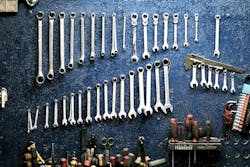There are three big stakeholders in the repair—the manufacturer, the repair shop and the insurance company, says Clint Marlow, director of claims innovation and customer experience at Allstate. But the question for him is: How can a repair facility go about strengthening the argument of their repair to the insurance carrier?
Documentation, Marlow says.
While most shops routinely follow OEM repair procedures these days, he says that simply following those requirements doesn’t guarantee payment. The insurer may not accept those procedures unless there is proof of its necessity.
Marlow says that if a repairer follows three simple steps, he or she can save a lot of time and, potentially, a lot of money in the long run.
This information is assuming a shop does not already have agreements and terms with insurers, he says. For DRP shops, the insurance carrier and the shop often have already reached terms about what cases the shop can charge for a repair and what cases they cannot charge.
For example, one MSO has been able to reach an agreement that the shop will not be reimbursed for diagnostic scans if the trouble code from the scan does not relate back to the loss. These agreements often form through MSOs versus independent shops because of the volume of repair the shop has been producing.
While repairers can choose to seek additional reimbursements for the repair at a later time when the shop and insurance company do not agree on the payment, the procedures for legal action vary in each state, he says. Additionally, the time it takes to gain more money after the repair is a long and burdensome process.
Marlow shares steps that shop owners can follow to make sure they have the proper documentation when meeting with the insurance agent.
As told to Melissa Steinken
1. Have proof the repair was done.
For the example of pre- and post-repair scanning, make sure there is documentation of the state of the vehicle at the initial scan and the state of the vehicle at the end.
This proof can be assembled in a “demand package.” The package would include any OEM repair procedures recommended to the shop and list out the advanced driver-assistance systems with which the vehicle comes equipped.
You have to justify your argument of the repair because some of these technologies are newer to the industry and it does take them a bit longer to become widely accepted.
2. Prove the documentation is related to the loss.
The important thing to keep in mind is how the repair that is performed is related to the loss. We, as an insurance company, owe for damages related to the accident. Specifically, include the scans related to damage from the accident.
After the documentation is presented to the insurer, there might be a quality assurance process in place at some carriers. This would mean that re-inspection personnel are focused on the fact that the insurer pays the right dollar amount for the repair.
A reasonable cost factor is typically based on the region’s labor rate per hour. For example, the pre- and post-repair diagnostic scanning would typically be paid in a range of $100–$300. Insurers determine the reasonable pay based on other factors, as well, including how much the equipment cost and how long the equipment used in the repair is able to work.
3. Take the time to show why you did the repair.
Lastly, take time to not only show that the repair was done, but also why the repair was done.
This might just be a process of printing the documentation of the diagnostic scans and why the repairs were needed. Then, it might be an additional five minutes of work to describe the specific ADAS features on the vehicle. In total, this documentation process could take an extra 10 minutes.
Simply showing the advanced technology on the vehicle could make the difference between an insurer not arguing about paying for the repair. Again, this is based on the repair amount being reasonable and not, say, exceeding $1,000 for a scan.
Some insurers will look at the vehicle and determine that if it’s a 12-year-old vehicle and only has advanced features like autonomous braking, then the pre-repair scan and the post-repair scan is not essential for the repair. But, the shop might be stuck in the middle of a conflict and having the manufacturer say the shop needs to conduct scans for every vehicle.
These types of documents and information from the repair can help solve arguments between shops and the insurer 95 percent of the time.
About the Author

